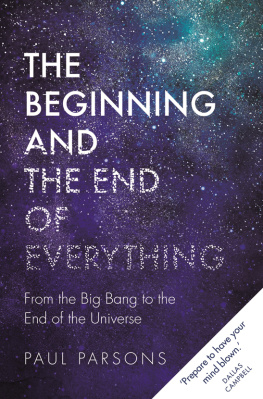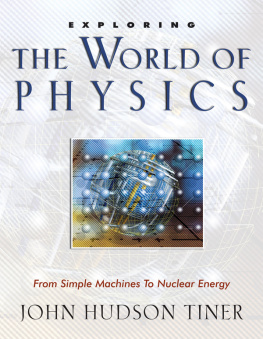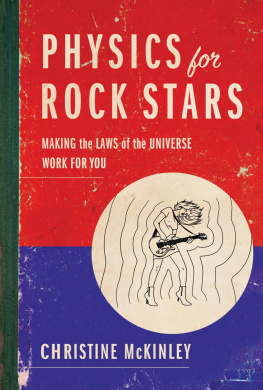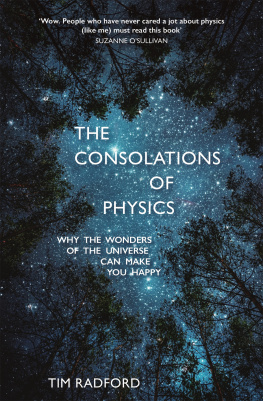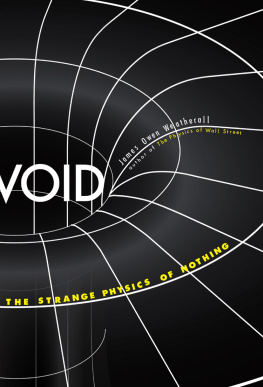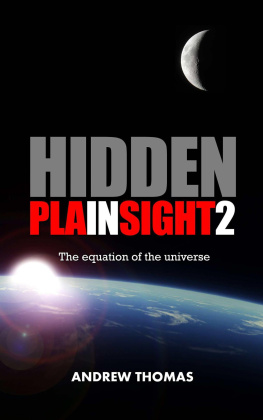Dr. Paul Parsons is a regular contributor to Nature, New Scientist and the Daily Telegraph. He was formerly editor of the BBCs award-winning science and technology magazine Focus. The Science of Doctor Who (Icon Books) and was longlisted for the Royal Society Prize for Science Books. His last book was Science 1001, published by Quercus.
HOW TO DESTROY THE UNIVERSE
And 34 Other Really Interesting Uses of PHYSICS
PAUL PARSONS


New York London
2011 by Paul Parsons
All rights reserved. No part of this book may be reproduced in any form or by any electronic or mechanical means, including information storage and retrieval systems, without permission in writing from the publisher, except by reviewers, who may quote brief passages in a review. Scanning, uploading, and electronic distribution of this book or the facilitation of the same without the permission of the publisher is prohibited.
Please purchase only authorized electronic editions, and do not participate in or encourage electronic piracy of copyrighted materials. Your support of the authors rights is appreciated.
Any member of educational institutions wishing to photocopy part or all of the work for classroom use or anthology should send inquiries to Permissions c/o Quercus Publishing Inc., 31 West 57th Street, 6th Floor, New York, NY 10019, or to .
ISBN 978-1-62365-246-3
Distributed in the United States and Canada by Random House Publisher Services
c/o Random House, 1745 Broadway
New York, NY 10019
www.quercus.com
CONTENTS
INTRODUCTION
Why is it that when you read about physics in popular books, its always about accelerating subatomic particles to near the speed of light in an attempt to unlock the ultimate secrets of the Universe, and yet when you study it at school all you end up doing is measuring the temperature of some ice in a bucket?
Perhaps thats an exaggeration but its not really a surprise that for all too many people, physics lessons were boring. Tediously, mind-achingly, duller than defrosting the fridge on a rainy Sunday, boring.
When I was at school I had two physics teachers. One, Mr. H, spoke with a lisp and walked like the soles of his shoes were made of Zectronthat super-springy stuff they used to make balls that, if you lobbed them at the ground hard enough, could bounce right over your house. Despite his comical comportment he was, sadly, a droning bore. Albert Einstein once remarked how odd it is that an hour spent in the company of a pretty girl seems like a minute, while a minute with your hand on a hot stove seems like an hour. Thats relativity, he said. If only the great man could have come along to one of Mr. Hs classes, he could have witnessed time actually appear to run backward. I developed a deep loathing for the sections of the syllabus that Mr. H inflicted upon uswhich, included thermodynamics (the science of temperature, ice and, yes, buckets).
My other physics teacherMiss Mwas four foot ten and, so the story goes, had the power to make the school bully blubber without even raising her voice. Neither I nor any of my friends sympathized with school bullies but, nevertheless, we all regarded Miss M as quite terrifying and definitely not one to be aggravated. Homework was delivered promptly. That said, she was also perhaps the best physics teacher in the world. The vagaries of radioactivity, wave theory, gravity, optics, and all that other stuff, suddenly became clearer than centrifuged Evian. Not only that, but I dont ever recall being bored. Scared, yes. Bored, definitely not.
Thanks to Miss M, a very mediocre secondary school physics student was able to go away to university and ended up completing a doctorate in cosmology. Yes, that was me. I say able to but perhaps wanted to was her biggest achievement. I started off with next to no interest in physics, education or having a career of any sort, and came out of school inspired, largely as a result of her efforts.
But why should it take such a good teacher to make physics interesting? Physics, I think its safe to say, is the best of all the sciences. Thats not just because it covers nuclear explosions, which are the biggest explosions were able to make. Or because it deals with space, which is inherently cool. Its more because physics is the most fundamental of all the sciences. As the great Ernest Rutherfordthe man who first split the atomonce declared, Physics is the only real science. The rest are just stamp collecting.
I think what Rutherford meant is that physics underpins the fundamental behavior of the Universefrom that, everything else follows. The interplay between the subatomic particlesin particular, electrons orbiting around atomsis what determines the laws of chemistry. And biology is just the chemistry governing the strange set of chemical reactions we call life. Life is classified into families and speciesbut giving things names and maintaining lists is no more innovative than keeping stamps in an album But I digress.
This book is your very own Miss M. I hope it wont scare you quite as much as she scared me and my friends, but the aim in writing it was much the same as her goal in teaching us: to provide an interesting and accessible guide to the big ideas in physics. I dont mean just the usual interesting fare of relativity and subatomic particle physics, but also mechanics (the science of moving objects), electromagnetism (the science of electric and magnetic fields) and even thermodynamics (temperature, ice and buckets). Along the way, Ive tried to include some history of the subject and to put it all in a real-world context so that it doesnt all seem like blue-sky science.
Of course, theres plenty of blue-sky science in here toorelativity and subatomic particle physics, along with antigravity, parallel universes, teleportation, time travel, immortality, invisibility and higher dimensions of space and time. Youll find out how to save the planet from energy shortages by mining the vacuum of empty space, engineer the Earths climate to reverse the effects of global warming, and fend off killer asteroids like Bruce Willis and his vest. Youll learn essential survival skills such as how to live through a lightning strike, tough it out during an earthquake and fall into a black hole without being squashed into spaghetti. And youll discover some plain old cool stuff like how to turn lead into gold, travel to the center of the Earth, crack supposedly unbreakable codes and use physics to predict the stock market.
Look at it this way: I got a physics education; youre getting the keys to world domination. Is that a good deal? This ones for you, Miss Mwe salute you!
CHAPTER 1
How to build the ultimate rollercoaster
Gravitational energy
Launch catapult
G-forces
Centripetal force
Mind the gap
Being accelerated from zero to 100 km/h (60 mph) in a little over a second, turned upside-down, spun round at over five times Earths gravity and then dropped 100 m (330 ft) might not be everyones cup of tea. But for rollercoaster thrill junkies its their idea of heaven. The ultimate rollercoaster ride is a delicate balancing act between safety and being scared witless.
Gravitational energy
After an age spent queuing you finally climb aboard, buckle in and wait anxiously for the off. Youve never done this before and arent quite sure what to expect, although the green-faced individuals youve just watched stumble from the ride give you a fairly good idea. Amid fleeting concerns for your wellbeing, the controllers voice crackles over the tannoy: Go, go, go! The car lurches forward and starts to accelerate. Most rollercoaster cars do not have their own internal power source. In fact, they are not propelled at all for most of the duration of their journey. Instead, they are hauled to the top of a high peak and then released. It is the speed the cars gain during this initial drop that provides the energy needed to carry them around the rest of the track. The rollercoaster really does coast the majority of the way. That this is possible at all comes down to a central principle of physics known as the conservation of energy. It says that when you add up the amount of all the different forms of energy locked away in a physical system you get a numberthe total energy of the systemthat must remain constant with time. Energy in the system is allowed to change from one type into another, but the sum total must always be the same.
Next page

